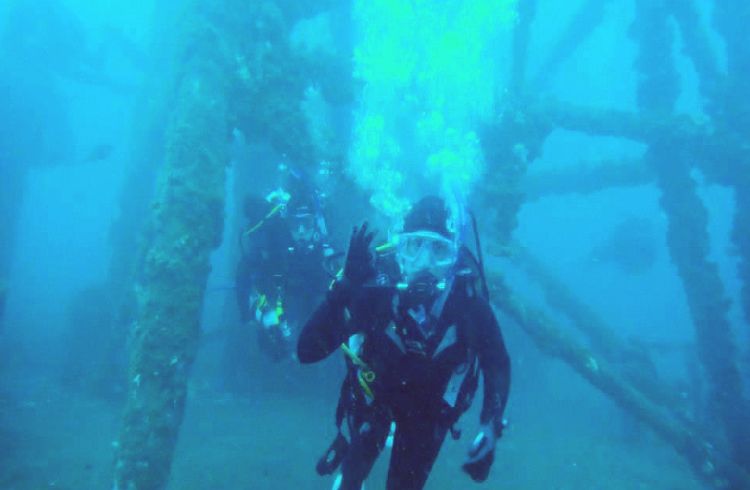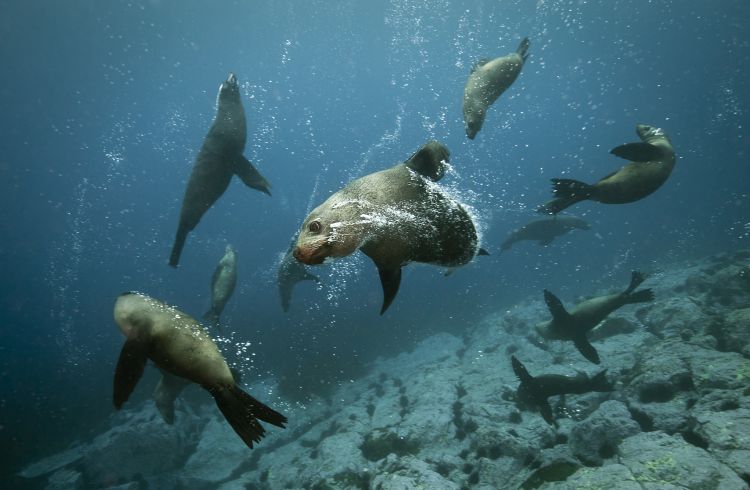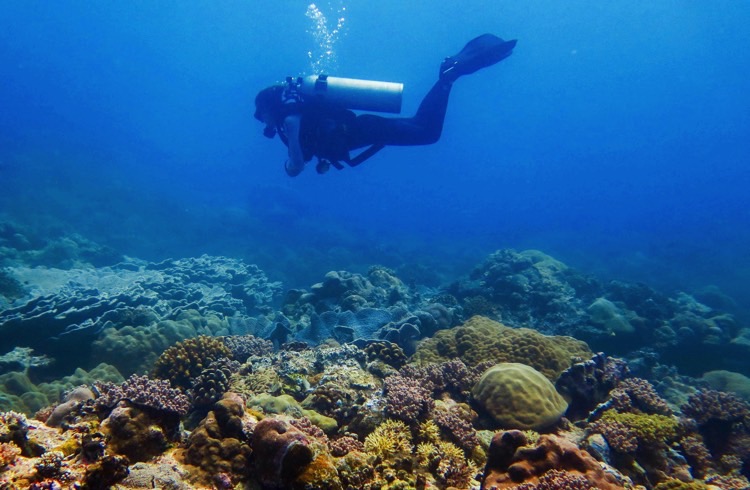Australia's east coast has more to see under the sea and there are plenty of spots from Queensland to Tasmania. Scuba diver and World Nomads writer Allyson Jennings shares her picks on where to go to get wet.
 Photo © GettyImages/seanscott
Photo © GettyImages/seanscott
Australia's east coast is home to many scuba diving spots, offering everything from shipwrecks, colorful corals, and shark-filled caves to watching the underwater ballet of fur seals.
During humpback whale migration season (May to November), these giants of the deep can often be spotted at various locations. Seeing them and hearing their song adds an extra special touch to scuba dives on the east coast. Here's where to see the best underwater life along the east coast.
Queensland
SS Yongala
Location: Townsville
Dive Type: Boat
Year Sunk: 1911
History: A steam passenger ship sailing from Cairns to Melbourne, the SS Yongala ran into trouble after she sailed into the path of a cyclone and sank, killing all 122 people on board. The wreck was discovered in 1958 and is considered one of the best wreck dives in the world due to its biodiversity and intact structure.
Diving Level: Open Water (minimum six dives). Check with the dive operator before departure for more information due to the wreck depth and occasional strong currents.
What you can see: It's a great spot for macro marine life such as sharks, rays, fish, turtles, sea snakes, eels and more.
Lady Elliot Island
Declared a No-Take fishing zone in 2005, Lady Elliot Island has become one of the most biodiverse spots on the Great Barrier Reef, with tiny marine critters and big ocean giants (such as manta rays, turtles and at the right time of year, whales) calling it home.
Location: At the southern end of the Great Barrier Reef, between Fraser and Lady Musgrave Islands.
Dive Type: Boat
Diving Level: Open Water
What you can see: Lady Elliot is one of the best spots on the reef to see giant manta rays and several species of turtle all year around. Plus, a large variety of fish species, corals, clams, starfish and many other small marine creatures which call the many bommies, caves, and reefs home. The wreck of the

Ex HMAS Brisbane (II)
Location: Mooloolaba, Sunshine Coast
Dive Type: Boat
Year Scuttled: 2005
History: HMAS Brisbane was one of three Perth-class destroyers commissioned for the Royal Australian Navy between 1967 and 2001. She and her crew saw active service in the Vietnam and first Gulf wars and helped out in the aftermath of Cyclone Tracy in 1974.
Diving Level: Open Water. The main deck is approximately at 59ft (18m), however, you can go deeper if you have advanced/deep certification.
What you can see: Aside from exploring the engine and control rooms, the wreck has become a hub for marine life, with resident Queensland groupers, lionfish, octopus, fish of all shapes and sizes, rays and Shovelnose sharks.
Wolf Rock
One of several aggregation spots along the east coast, and on the doorstep of Fraser Island, Wolf Rock is home to the so-called “labradors of the sea”, the critically endangered Grey Nurse sharks (also known as Sand Tiger or Ragged Tooth).
Location: Rainbow Beach, Sunshine Coast
Dive Type: Boat
Diving Level: Open Water
What you can see: Grey Nurse sharks, bull rays, sea snakes, turtles, eagle rays, manta rays, numerous fish species, crabs, nudibranchs (sea slugs), octopus and more.
New South Wales
Often overshadowed by Queensland, New South Wales has some of the best diversity when it comes to scuba diving, with tiny sea creatures, sharks, turtles, rays, seals, and more. The coastline is also dotted with wrecks.
Julian Rocks
Location: Byron Bay
Dive Type: Boat
Diving Level: Open Water
What you can see: Worth diving all year round, the sealife here can vary depending on seasonal migration. In summer-autumn, divers can hang out with leopard sharks and manta rays. During the cooler months of the year, grey nurse sharks will arrive. Resident animals include turtles, fish, wobbegongs, eagle rays, starfish, anenomes and, if you’re lucky, you might even find Nemo.

Solitary Islands
Location: Offshore from Coffs Harbour, the Solitary Islands Marine Park is the meeting point of the warm tropical waters of the Great Barrier Reef and the cooler, temperate waters from the south.
Dive Type: Boat
Diving Level: Open Water
What you can see: A great mix of tropical and sub-tropical marine life, colorful corals, sponges and
South West Rocks – Fish Rock
Location: South West Rocks, Mid North Coast
Dive Type: Boat
Diving Level: Open Water
What you can see: Home to a resident population of Grey Nurse sharks, Fish Rock is a fantastic dive site with large schools of fish and a cave swim-through, as well as a hub for all types of sub-tropical and tropical marine life. South West Rocks often rates amongst the best dive sites in Australia, particularly for shark diving.
Ex HMAS Adelaide (II)
Location: Terrigal, Central Coast
Dive Type: Boat
Year Scuttled: 2011
History: An Adelaide-class guided missile frigate, HMAS Adelaide was commissioned by the Royal Australian Navy between 1980 and 2008. She and her crew served during the first Gulf War and undertook peacekeeping operations in Timor Leste.
Diving Level: Advanced, Deep or Advanced Adventure with 98ft (30m) dive.
What you can see: At 453ft (138m) long and 49ft (15m) wide, the coral-crusted ship has several decks, helicopter hangars and other places to explore.

Bare Island
Location: La Perouse, Sydney
Dive Type: Shore
Diving Level: Open Water
What you can see: One of Sydney’s most prominent dive spots, Bare Island offers a variety of marine life, from tiny pipefish, weedy sea dragons, Port Jackson sharks, wobbegongs, pineapple fish, blue devilfish, nudibranchs of all kinds and more, all living among sponge gardens, seaweed, rocky overhangs and platforms. If you're lucky, you may also spot the Bare Island Angler Fish.
Montague Island
Location: Narooma, South Coast NSW
Dive Type: Boat
Diving Level: Open Water
What you can see: Montague Island is the prime spot to dive, with Australian and New Zealand Fur Seals all year around. Grey Nurse sharks will also aggregate here seasonally. There are also plenty of rays, wobbegongs, blue grouper and other marine creatures. If you can’t scuba, you can also snorkel with the seals.

Victoria
Rye Pier & Blairgowrie Pier
Location: Mornington Peninsula
Dive Type: Shore
Diving Level: Open Water
What you can see: Spider crabs, which mysteriously flock to these piers in their thousands during winter for their annual shell moult. As a result, they had a starring role in David Attenborough's Blue Planet II. Plus, there are other marine animals such as stingrays, octopus, fish, angel sharks and lots of smaller marine life like nudibranchs and seahorses.
Ex HMAS Canberra (II)
Location: Offshore from Ocean Grove, just outside Port Phillip Bay.
Dive Type: Boat
Year Scuttled: 2009
History: An Adelaide-class guided missile frigate, HMAS Canberra was commissioned by the Royal Australian Navy between 1981 and 2005. She and her crew served on several peacekeeping operations and also spent time in the Southern Ocean patrolling for illegal fishing activity, apprehending several foreign vessels poaching Patagonian toothfish.
Diving Level: Open Water. The main deck is approximately at 59ft (18m) however, if you wish to go deeper, you will need advanced/deep certification.
What you can see: At 453ft (138m) long and 49ft (15m) wide, the ship has several decks, helicopter hangars, and plenty of places to explore such as the bridge, galley, and quarters. Since it was scuttled, the ship has become an artificial reef hosting a variety of marine life such as anenomes, seahorses, seadragons, schools of fish, algae, soft corals, sponges, crabs, and other crustaceans, plus larger marine creatures.
Tasmania
Cathedral Cave
Location: Tasman Peninsula
Dive Type: Boat
Diving Level: Advanced/Deep Experienced. Buoyancy control is a must.
What you can see: Australia's largest sea cave, Cathedral Cave welcomes divers through its massive opening, which leads into a maze of caves and passages. Access to this site is weather-dependent, so check with your dive operator. Marine life includes weedy seadragons, turtles, fish, cuttlefish plus small marine animals like nudibranchs and sea spiders.
Tasman Peninsula
With shipwrecks, caves and an abundance of life including curious fur seals, the Tasman Peninsula has something for all experience levels. Spots to check out include:
- SS Nord - for experienced divers, the 266ft (81m) SS Nord lies at a depth of 138ft (42m) and is one of the few remaining intact shipwrecks left. The cargo ship met its watery grave in 1915 after hitting Needle Rock (near Hippolyte Rocks
), and is now covered with colorful hard and soft corals which provide a habitat for fish of all kinds including big pelagic species such as barracudas and groupers down to smaller species such as angelfish. For advanced/deep divers only. - The Lanterns - a great spot to hang with fur seals and suitable for all levels of dive experience.
- Hippolyte Rocks - A deep wall dive spot with drop offs, macro marine life such as fish, sharks, and seals, and small marine invertebrates, such as shrimp and crabs, hiding in the nooks and crannies; plus an abundance of corals and sponges can also be found. For advanced/deep experienced divers.
Maria Island
Home of the Troy D, a 180ft (55m) hopper barge, which was scuttled in 2007 to create an artificial reef, it is accessible by boat and suitable for experienced divers. The wreck has truly lived up to its purpose; it's now encrusted with hard corals, and divers can see sharks, seals, eels, large fish such as barracuda, and smaller fish which hide in the wreck.
Dive Safety Tips
- Avoid touching any marine life. It may be dangerous, and the ocean ecosystem has many delicate corals and other organisms which can be crushed by touching.
- Always dive within your certification limits.
- Never skimp on the surface interval between dives.
- Never dive in an area you are unfamiliar with, alone or with a buddy. Always go with a certified and licensed operator staffed with experienced guides who know what the potential risks are at the dive site, e.g. strong currents. Always dive with a buddy or in a group.
Related articles
Simple and flexible travel insurance
You can buy at home or while traveling, and claim online from anywhere in the world. With 150+ adventure activities covered and 24/7 emergency assistance.
Get a quote

No Comments